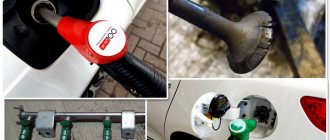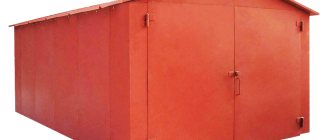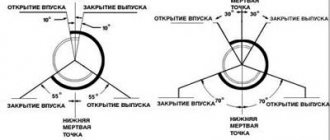The compression ratio is a value that is typical for internal combustion engines. The engine compression ratio is the ratio of the total volume of the cylinder to the volume of the combustion chamber. In other words, it is the ratio of the volume of space above the piston when it is at BDC (bottom dead center) to the volume of the same space above the piston when it is at TDC (top dead center).
It is worth noting that the concept of engine compression ratio is often mistakenly taken as an indicator of compression. Compression is the maximum level of pressure in the cylinder that is created as a result of the piston moving from BDC to TDC. The compression ratio is usually measured in atmospheres, while the compression ratio is expressed mathematically as a certain ratio. An example would be a compression ratio of 11:1.
We also recommend reading the article about what compression is in an engine. In this article you will learn how to measure compression yourself.
In fact, the compression ratio is conditionally the difference in pressure in the combustion chamber between the moment the fuel-air mixture (or only diesel fuel for diesel internal combustion engines) is supplied to the cylinder and the moment when the fuel charge ignites. Different engines may have different compression ratios, depending on the type of motor and its design features. It is customary to distinguish between low and high compression ratios.
What is engine compression ratio
Conventionally, the amount of compression is also represented as the ratio of pressures in the device during the supply of fuel and the explosion of the mixture. This particular degree is determined by the design of the car engine, and can be high or low.
Before the actual process of ignition of the combustible mixture, the pistons compress the fuel to a certain volume. Engineers are able to vary this indicator, calculating it at the design stage. Having learned the quantitative ratio of this value to the volume of the combustion chamber, one can draw various conclusions.
On gasoline power plants, the compression ratio reaches a maximum of 12 units. The higher the engine compression ratio or SSD here, the greater the specific power of the engine. However, with a strong increase in this indicator, the resource of the unit decreases, especially when refueling with low-grade gasoline. On diesel engines, due to their technical differences, it can vary from 14 to 18 units.
In gasoline engines with a compression ratio increased to 12 units, nothing other than AI-98 Premium can be poured. Obviously, this will significantly increase fuel costs.
The concept of compression, its measurements
There is no such characteristic among the technical data specified in the vehicle’s operating manual. There is a slightly different concept - compression ratio. There is no direct relationship between these two parameters; they are united by only one thing - in both cases we are talking about pressure.
- The compression ratio is a calculated constant value; it has no dimensional units. For the VAZ 2106 engine and its modifications it is 8.5. This figure is the result of dividing the total working volume of the cylinder by the volume of the combustion chamber. In simple words, the air-fuel mixture entering the cylinder space is compressed 8.5 times by the upward moving piston.
- Compression is a variable value; its value depends on the technical condition in which the engine is located. This parameter shows what pressure occurs in each individual cylinder when the crankshaft rotates using the starter. It is measured with a pressure gauge, which is screwed in instead of a spark plug, the unit of measurement is 1 kgf/cm2 or 1 Bar, which is almost the same thing (1 kgf/cm2 is equal to 0.98 Bar).
Compression is measured to determine the degree of wear of the cylinder-piston group. Its values were obtained experimentally, in practice. The measurement is performed as follows: all 4 spark plugs are unscrewed, and in their place, a pressure gauge with a check valve is screwed into each cylinder one by one, and by rotating the starter, the maximum pressure that can be pumped by each piston is determined. In the VAZ 2106 engine, the ideal figure is 13 kgf/cm2, but this is a rare case; such pressure is found on new, only run-in engines.
What does it affect?
SSD directly determines the amount of work produced by the internal combustion engine. The higher the compression ratio is initially calculated, the more productive the ignition will be. The output of the motor will increase proportionally. Let us remember how developers in the 90s tried to increase this figure without completely modernizing the engine. In this way, they competed with each other, making the units more powerful without spending a lot of money. But what’s most interesting is that the engines in this case did not consume more fuel, and even became more economical.
However, there is a limit to everything, and as mentioned above, too high a coefficient leads to a decrease in the life of the internal combustion engine. Why is this happening? The fact is that with significant compression, the fuel mixture begins to spontaneously detonate and explode. This especially affects gasoline-powered units, so here this coefficient has a strict limitation.
Remember that the use of low-octane fuel causes detonation on units with increased SSD. Conversely, high-octane fuel may not allow the engine to fully open if used in units with a low compression ratio. For this reason, both parameters must match. More details in the table below.
The difference between compression ratio and compression
The compression ratio of an engine is not compression. They are completely different, although many people confuse them. The coefficient discussed in the article does not reveal the value of the optimal fuel assembly pressure before combustion. SSD is measured only relatively, in relation to a unit volume of the chamber.
Compression is usually understood as the limiting value of compression formed in the combustion chamber at the final stage of pressure of the combustible mixture. This value a priori cannot be relative, so it is measured in absolute values - atm, kg/cm2, bar.
Compression ratio and compression are inextricably linked, but not identical. The compression ratio depends not only on compression. It is influenced by the temperature of the internal combustion engine, the presence of gaps in the drive valves, the composition of the fuel and much more.
What are the cylinder compression standards for VAZ engines?
Engine specifications must indicate “minimum cylinder compression values.” If you cannot find such data, determine the compression standards yourself using the formula:
| Compression (kgf/cm2) = compression ratio (see technical specifications of internal combustion engine) * coefficient (for VAZ min 1.2, max 1.3) |
- The compression ratio of modern VAZ 21126 and VAZ 21127 engines installed on Granta, Kalina and Priora is 11. We multiply the values using the formula and get the compression standards: 13,2..14,3.
- For the Vesta engine (VAZ-21129) the compression ratio is 10.45, the compression standards will be: 12,5..13,6.
- For Niva (VAZ 21213, 21314) - 11,3..12,2.
If the compression gauge values in all cylinders are within the normal range, this does not mean that everything is fine. Different compression in the cylinders is also bad. It is important that the difference between all readings is minimal. Compare the minimum and maximum compression values in the cylinders. According to technical standards, the difference should be no more than 1 kgf/cm2 or 10% .
Calculation of compression ratio
Due to the fact that it is desirable to increase the compression ratio to a certain value, it is necessary to be able to calculate this indicator. In addition, this will make it possible to avoid detonation moments that destroy the power unit from the inside during the boost process.
Thus, the need to measure this indicator is required in cases such as:
- engine boost;
- adjustment for fuel with a different AI or for methane fuel with an octane rating of 120;
- post-repair adjustment.
Compression in the engine of a VAZ 2106 car
Considering the fact that over 4 million VAZ 2106 models were produced, there are still quite a lot of them on our roads. Accordingly, questions regarding the repair of the legendary “classics” still remain relevant. For example, the question of what compression should a working six engine maintain.
Turbocharged engines
On turbo engines, the calculation of the compression ratio is different. This is due to the presence of air pressure. Therefore, in this case, the value obtained during the calculations is multiplied by the turbocharger indicator.
In addition, when calculating the compression ratio of turbocharged engines, not only the boost pressure is taken into account, but also the effective compression indicator, climate changes and much more. In this case, the process becomes significantly more complicated compared to measurements on an atmospheric engine.
Counting example
This is what the generally accepted calculation formula for an automobile internal combustion engine looks like: “SSD = (RO+OKS)/OKS.” The compression ratio here is o, the working volume of the cylinder is “RO”, and the volume of the combustion chamber is “OKS”.
To calculate “PO,” you must first decompose the single engine volume or displacement into the number of cylinders used. For example, the displacement of the “four” engine is 1997 cm3. To determine the capacity of one cylinder, you need to divide 1997 by 4. You get about 499 cm3.
To calculate the “OCS” parameter, specialists use a tube or pipette calibrated in cm3. The chamber refers to the place where the fuel ignites directly. The chamber is primed and then the volume is measured using a liquid burette. If you don't have a graduated tube, you can pump out the liquid with a syringe and then measure it in a measuring cup or on a scale. In this case, it is advisable to use clean water for calculations rather than gasoline or diesel fuel, since its specific gravity is more related to the volume in cm3.
Attention! To accurately measure “OKS”, the thickness of the cylinder head gasket is additionally added, the shape of the piston crown and other features are taken into account. Therefore, it is recommended to entrust the calculation of this value to specialists.
Reasons why there is no compression in the cylinder
Poor (small) compression in one or all cylinders indicates engine wear. There is an old and simple way to determine why compression has disappeared. You need to pour a tablespoon of engine oil into the spark plug hole and repeat the measurements:
- if the pressure has increased noticeably, it means the piston rings have poor sealing;
- if the pressure has not changed, then there may be several reasons (for example, leaking valves, broken gaskets under the cylinder head, there is a crack or burnout in the walls of the combustion chamber, in the piston bottom).
There is another, more accurate way to find out why compression has disappeared. To do this, you will need to modify the spark plug. We remove the insulator from it, and weld the valve of the car camera to the metal body. Next, set the cylinder piston to the ignition timing position, remove the radiator caps and oil filler neck, screw in the manufactured adapter and pump air into the cylinder using a pump (create pressure in it):
- if air enters the exhaust pipe, it means the exhaust valve is poorly sealed;
- If air goes into the intake manifold, there is a problem with the intake valve.
- if bubbles appear in the expansion tank, then check the cylinder head gasket;
- If there is a hissing sound in the oil filler neck, it means that the piston rings are not properly sealed.
Engine diagnostics using compression measurements in the cylinders allows you to quickly and accurately determine its condition without disassembling, and in some cases will help avoid major repairs of the power unit. Have you ever experienced a lack of pressure in the cylinders? What was the cause of the malfunction? If engine problems persist, check the fuel rail pressure.
Source
How to increase engine compression ratio
If you need to increase this indicator, use several methods:
- boring the block and installing pistons with a large diameter;
- reducing the volume of the combustion chamber by removing the metal layer at the cylinder head connection.
We must not forget that in some cases the installation of upgraded pistons will be required. This is done to eliminate such an undesirable consequence as the pistons meeting the valves. In particular, the valve recesses on the elements are increased. Also, the valve timing must be adjusted again.
Interestingly, Japanese manufacturers have revealed the potential of internal combustion engine compression ratios best of all. While European auto companies went the route of improving hybrid engines, the Japanese managed to increase the SSD to 14 units on gasoline power units, using a variable value. But how is this possible without detonation moments? Everything turned out to be simple. It turns out that you need to cool the chamber where the fire occurs. Then you can safely compress the mixture. And it is not at all necessary to use cool air for this: it is enough to modernize the exhaust system.
A technique that has long been known from racing engines. The exhaust channels are changed according to the 4-2-1 scheme. Portions of exhaust gases do not interfere here; they fly out one by one into the chimney. Thanks to such a clear exhaust system, the purging of the cylinders is improved, where less hot gases remain.
The secret of the Japanese formula, according to which you can safely compress a combustible mixture, has a strictly mathematical relationship. So, if the exhaust percentage is reduced by 2 times, the SSD can be raised by 3 units, but no more. If you also cool the air entering the cylinders, you can add one more unit.
However, to implement this method, it will be necessary to modernize the gas exchange by forking out for phase shifters of both camshafts. In addition, some aspects will need to be improved. For example, changing the length of the piston stroke through computer intervention.
A variable coefficient system is used on many Japanese engines, for example, for Inflniti. The ability to automatically change this compression ratio depending on the load can significantly increase the efficiency of the engine, especially a turbocharged one. Each portion of the mixture burns at the optimal compression at the moment. So, if the load on the engine is insignificant and the mixture is lean, maximum compression is turned on. Conversely, in loaded mode, the minimum degree is used, since a lot of gasoline is injected and detonation is possible.
Thus, the advanced system for changing the SSD makes it possible to halve the engine displacement, while maintaining power and dynamic characteristics.
A trend towards increasing the engine compression ratio was also observed in the mid-20th century in the USA. The bulk of American engines produced in the 70s were in the range of 11-13 units. But they only worked on very high-quality, high-octane fuel obtained by leading. After leading was banned, a decrease in the compression ratio was observed in serial samples of internal combustion engines.
It is important to know that the increase in power will be most noticeable on engines that normally operate at a low compression ratio. For example, engines with an indicator of 8 units, increased to 10, will produce more power than units with a stock parameter of 11 units, boosted to 12.
Stories from our readers
“Fucking basin. "
Hi all! My name is Mikhail, now I’ll tell you a story about how I managed to exchange my two-wheeler for a 2010 Camry. It all started with the fact that I began to be wildly irritated by the breakdowns of the two-wheeler, it seemed like nothing serious was broken, but damn it, there were so many little things that really started to irritate me. This is where the idea arose that it was time to change the car to a foreign car. The choice fell on the melting Camry of the tenth years.
Yes, I had matured morally, but financially I just couldn’t handle it. I’ll say right away that I am against loans and taking a car, especially not a new one, on credit is unreasonable. My salary is 24k a month, so collecting 600-700 thousand is almost impossible for me. I started looking for different ways to make money on the Internet. You can’t imagine how many scams there are, what I haven’t tried: sports betting, network marketing, and even the volcano casino, where I successfully lost about 10 thousand ((The only direction in which it seemed to me that I could make money was currency trading on the stock exchange, they call it Forex. But when I started delving into it, I realized that it was very difficult for me. I continued to dig further and came across binary options. The essence is the same as in Forex, but it’s much easier to understand. I started reading forums, studying trading strategies. I tried it on a demo account, then opened a real account. To be honest, I didn’t manage to start earning money right away, until I understood all the mechanics of options, I lost about 3,000 rubles, but as it turned out, it was a precious experience. Now I earn 5-7 thousand rubles a day. I managed to get the car buy after half a year, but in my opinion this is a good result, and it’s not about the car, my life has changed, I naturally quit my job, I have more free time for myself and my family. You’ll laugh, but I work directly on the phone)) If If you want to change your life like me, then here’s what I advise you to do right now: 1. Register on the site 2. Practice on a Demo account (it’s free). 3. As soon as you get something on the Demo account, top up your REAL ACCOUNT and go to REAL MONEY! I also advise you to download the application to your phone, it’s much more convenient to work from your phone. Download here.
Table of approximate increase in engine power with increasing compression ratio:
| Increasing the compression ratio | Increase in engine power |
| from 8 to 9 | 2,0% |
| from 9 to 10 | 1,7% |
| from 10 to 11 | 1,5% |
| from 11 to 12 | 1,3% |
| from 12 to 13 | 1,2% |
| from 13 to 14 | 1,1% |
| from 14 to 15 | 1,0% |
| from 15 to 16 | 0,9% |
| from 16 to 17 | 0,8% |
Intermediate results are summed up, for example, raising the compression ratio from 8 to 14 will give an increase of 8.7%.
Table: compression ratio and octane number of gasoline. Approximate dependence.
| Compression ratio | Petrol |
| from 9 to 10.5 | AI 92 |
| from 10 to 12.5 | AI 95 |
| from 12 to 14.5 | AI 98 |
Engine depowering: why it is needed and how to do it
Sometimes it is necessary to reduce the compression ratio. In this case, an additional metal cylinder head gasket is installed. You can use two gaskets instead of one, thereby thickening the gap - the volume of the chamber increases due to the height of the block head. A more complex method involves shortening the piston - removing the top layer on a lathe.
Engine depowering is usually a forced procedure. This is done, among other things, to reduce tax payments or to increase the resource of the unit. As you know, engines with a low compression ratio last longer and are less susceptible to wear. However, any such process is complicated by law to prevent unscrupulous owners from artificially lowering technical data.
As for reducing the compression ratio on turbocharged engines, it will require upgrading the electrical system with sensors, the entire piston group and injectors if it is a diesel unit.
In some cases, a swap is preferred to depowering, when a less powerful contract motor is installed instead of a standard one.











